The term “Gnosticism” in a nutshell has a rather broad scope.
Although the influence of Gnosticism can be seen in the background of Neo-Pythagoreanism, Neo-Platonism, etc., I will focus only on Christian Gnosticism in this article.
The historical background is the era of the Five Wise Emperors of Rome, a Christian thought movement that revolved around what the 18th century English historian Gibbon called “the happiest age in human history.
Contact point between Gnosticism and Buddhism
The word “gnosis” itself derives from the Greek word meaning “knowledge” or ” recognition.”
Research on Gnosticism was stimulated by the discovery of the Nag Hammadi Codex (“Nag Hammadi Document”), a large Gnostic document, in Egypt in 1945.
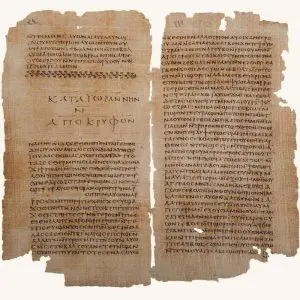
Nag Hammadi Manuscript, The Gospel According to Thomas
The connection between Christian Gnosticism and Buddhism seems to have been suggested by the English Buddhist scholar Edward Conze.
Conze points out that “Buddhists were in contact in southern India with the Christians of the Thomistic school (i.e., Christians who knew and used various texts such as the Gospel of Thomas).
There also seems to be historical evidence that Buddhist preachers had been proselytizing in Alexandria for generations when Gnosticism was at its height.
Conze also points out the similarities between Mahayana Buddhism and Gnosticism.
Based on Conze’s eight similarities, Holler lists the following similarities
- Liberation or salvation is achieved through liberating insights, i.e., gnosis and jñana.
- Ignorance, or lack of insight, is called agnosis or blindness and is the root cause of confinement in this world.
- Liberating insight comes not through external knowledge, but through internal revelation.
- Both systems order spiritual attainment hierarchically, from blind materialism to complete spiritual attainment.
- Wisdom plays an important role in both religions as the feminine principle personified in Sophia and Prajna.
- Christ and Buddha are portrayed as primordial beings, not mere historical figures.
- Both religions have an “anti-intellectualist” bent. That is, they disregard rules and social conventions in favor of higher spiritual attainment.
- Both systems target the spiritual elite, not the general public, and have hidden meanings and teachings.
Exploring the similarities between Christian Gnosticism and Buddhism
The following is a summary of the recommendations made by the “International Society on the Origins of Gnosticism” (1966: in Messina).
- Anti-Universe Dualism
- Conviction that there are “divine fireworks” and the “original self” within the human being
- The existence of a redemptive Revelator who makes man aware of his own true nature
I will discuss these three clues below.
Anti-Universe Dualism
Anti-universe dualism” clearly divides the world into two opposing worlds: this world, the inferior material world, and the original world, the home of the soul.
And this inferior material world was created by the God of the Old Testament “Genesis” (or “Demiurgos” in Gnostic terminology).
What follows from this is the idea that the supreme God, whom Jesus called “My Father, the Lord,” and the Creator God of Judaism (Old Testament) are two different entities.
When we honestly compare the New Testament with the Old Testament, we still feel a sense of discomfort.
It is certainly uncomfortable to think that the “God of judgment” and the “God of testing mankind” that appear throughout the Old Testament are the same as the “God of love” that Jesus believed in.
This motif is questionable for many, regardless of Gnosticism.
In his “Confessions,” the great Augustine repented of his youthful licentiousness and devotion to Manichaeism, but his original motivation for turning to Manichaeism was that he “could not logically believe in the God of the Old Testament.
Augustine then met his teacher, Ambrosius, and finally came to the point where he settled on the allegorical interpretation of the Old Testament, and finally took refuge in Christianity.
However, I still think it would be clearer to interpret the “God of judgment” in the Old Testament and the “God of love” that Jesus believed in as two separate entities.
The Creator God of the Old Testament is generally considered to be Yahweh, but is sometimes referred to as Elohim, one more time.
Elohim was originally considered the supreme deity in the Palestinian region.
Although biblical scholarship sometimes separates J (Yahweh) material from E (Elohim) material, I assume that Yahweh is the Jewish national god, and Elohim is the God of love and supreme God that Jesus believed in.
*Reference article: Yahweh and Elohim are Two Different Gods – Why It is Better to Distinguish between the Ethnic Gods and the Supreme God
Isn’t it strange that “the God of judgment, the God of envy (Yahweh)” is the supreme deity?
The Gnostic document “John Apocryphon” makes an astute point in this regard.
He said to them, “I am a jealous God. There is no god but I.” But by saying this, he was showing the angels that other gods do exist. For if there is no other God, who could he envy? (John Apocryphon)
When establishing a new religion, there is inevitably an aspect that the people will not easily follow unless one borrows conventional authority.
This may be manifested in the case of Christianity in the “fulfillment of Old Testament prophecies,” or in the writing of the genealogy of Jesus since Abraham.
This is true in Buddhism as well, with the Buddha stating in his early days to the effect that “My teaching is not original, but a discovery of the truths preached by the Buddhas of the past.
So this is how the idea of the seven Buddhas of the past came to be. In short, even the Buddha borrowed from the authority of tradition in the early days of the formation of the Order.
However, Shakyamuni gradually moved away from the authority of tradition, supported by the achievements of the Order’s 40-plus years of operation.
The “eternal Buddha” as referred to in the Lotus Sutra. There, the thought changes to that the Buddha’s true form is one with the fundamental Buddha, rather than having attained enlightenment through practice.
The “Eternal Buddha” may be interpreted as the equivalent of the supreme deity (Elohim) in Semitic monotheism.
Such an interpretation would provide an opportunity to integrate Christianity and Buddhism in a three-dimensional way.
*Reference article: Buddhism and Christianity – Theory to Overcome Differences and Extract Similarities
I think it is more natural to regard the emergence of the transcendent and absolute Buddha in Mahayana Buddhism as reflecting the Buddha’s own will in the real world.
Conviction that there are “divine fireworks” and the “original self” within the human being
There is a gnostic philosophy that this world is the product of an “inferior creator God,” but that there are “divine fireworks” and “inherent self” in human beings that are connected to the supreme God, and that it is important to recognize (gnosis) this.
Although it may be a bit too much of a denial of this world, such ideas as “divine fireworks” and “inherent self” are almost identical to the Buddhist concept of “buddhahood.
Jesus said, “If you bring out what is in you, it will save you. If you do not bring out what is in you, it will destroy you.” (The Gospel of Thomas)
While orthodox Christian doctrine interprets the “Father, Son, and Holy Spirit” and human beings as completely separate, and that human beings are solely to be redeemed, bearing original sin, Christian Gnosticism has a much stronger idea in its view of human beings.
The existence of a redemptive Revelator who makes man aware of his own true nature
According to the myth of Ptolemy, one of the Gnostic philosophers, there existed a higher world of “Pleroma” with the supreme god Propator as the highest, but after some twists and turns, the world and human beings were created by an inferior “god of judgment”.
As for the myth, I can’t deny that it is an “afterthought” that justifies Gnosticism….
The following two doctrines are much more positive ideas than mainstream Christian doctrine.
- The spiritual part of man is recalled by the revelation of Christ.
- Salvation for man is a prerequisite for recognizing(gnosis) the nature of his spiritual part .
I think it could be said that there is something here that has a common ground with Buddhist thought and is truly universal (catholic) in the true sense of the word.
We also notice that the concept of “resurrection” is also much more spiritualized and internalized than legitimate Christian doctrine, according to the “Gospel of Philip” in the Nag Hammadi document.
He said, “Those who say that a man must first die and then be resurrected are mistaken. One will receive nothing when he dies unless he first receives resurrection while he is alive” (“Gospel of Philip”).
This thought also has something in common with the Buddhist philosophy that the state of mind in the phenomenal world (this world) determines the destination in the real world (the other world).
Judeo-Christianity’s Idea of Reincarnation
The Carpocratians, a branch of Gnosticism, believed that if one did not experience everything in this life, the soul would be forced to reincarnate again.
It is even rather more radical than the Buddhist theory of reincarnation.
If we were to find evidence for reincarnation from the New Testament, we would find, for example, the following statements.
His disciples asked him, “Rabbi, who sinned, this man or his parents, that he was born blind?”(The Gospel according to John, 9:2.)
In this passage, the “this man” part, the fact that the cause of “born blind” is traced back in time suggests that he had a “previous life.
Another belief that spanned the Old and New Testaments was the “return of Elijah.
Now I am sending to you
Elijah[a] the prophet,
Before the day of the Lord comes,
the great and terrible day; (The Book of Malachi, 3:23.)
Elijah was a prophet of the 9th century B.C., and this “Book of Malachi” was written around the 5th century B.C., which suggests that the “second coming” was believed in even on a Jewish basis.
This Old Testament prophecy is the basis for John the Baptist and Jesus himself being regarded as “the second coming of Elijah” in the New Testament as well.
And they asked him, “Why do the teachers of the law say that Elijah must come first?” Jesus replied, “To be sure, Elijah does come first, and restores all things. Why then is it written that the Son of Man must suffer much and be rejected? But I tell you, Elijah has come, and they have done to him everything they wished, just as it is written about him.” (The Gospel of Mark” 9:11-13)
The “Trinity” is so central to Christian doctrine, even if it has little biblical basis, that it seems reasonable to accept that reincarnation has a clear biblical basis, as you can see from these quotations.
It is estimated that the history of Christianity and, by extension, the history of the world would have been very different if such a theory of reincarnation had been incorporated into legitimate Christian doctrine.
Theodicy, for example, is difficult to defend without reincarnation. It would be obviously unfair to include only this life.
*Reference article: Solutions to the Problem of Evil – Final Answer to Theodicy
Sophia and Prajna
The common link between Gnosticism and Buddhism is the feminine principle of Sophia and the wisdom of Prajnaparamita, the “Buddha Mother.
Etymologically, “prajnaparamita” is as follows
- Phra: ahead of time
- Jñā: wisdom
Prajnaparamita does not mean wisdom in the everyday sense of the word, but rather the profound wisdom of insight into the truth. The same is true of “Sophia” in Gnosticism.
In fact, some Western scholars have called the “Heart Sutra” a Buddhist gnostic scripture.
In fact, “gnosis” and “junya” are etymologically the same root.
Finally, what is the content of gnosis = knowledge and perception? I would like to quote Theodotus, one of the Christian Gnostics, as follows
It is a very philosophical question.
Who were we, what have we become? Where have we been, where have we been cast? Where are we headed, where are we liberated from? What is birth, what is rebirth?
Further, please refer to the article below for a detailed discussion of the basic theory of overcoming the differences between Christianity and Buddhism.
*Reference article: Buddhism and Christianity – Theory to Overcome Differences and Extract Similarities




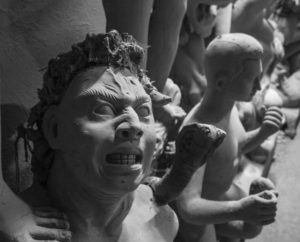
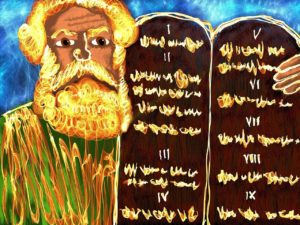

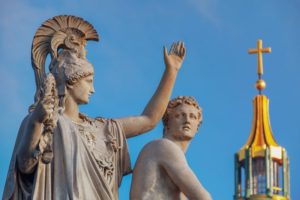

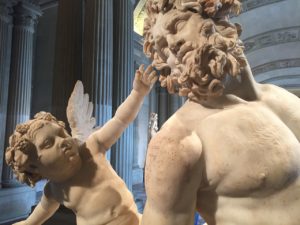

Comments